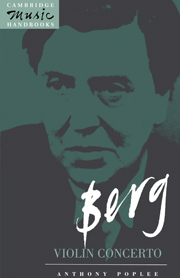4 - Form, materials and programme
Published online by Cambridge University Press: 05 June 2012
Summary
As is the case in the other works of Berg's maturity, the layout of the Violin Concerto is best understood against a background of formal conventions familiar from the music of the Classic and Romantic eras. This does not imply that the music merely conforms to the outlines of, say, textbook sonata or rondo forms; on the contrary, key features of such stereotypes are placed in focus just sufficiently for the listener to be alert to the ongoing play of near-repetitions, developments, variations and near-recapitulations by which the music renews and constantly expands its range of cross-reference. In this respect, the concerto exhibits a greater degree of freedom of association than the works between Wozzeck and Lulu, and reflects the gains in compositional technique which underpin the latter opera's sophisticated interaction between the libretto's dramatic and textual structure and the musical forms deployed in setting it.
In a letter to Schoenberg, dated 28 August 1935, Berg himself described the division of the concerto into two parts, each with two movements:
I a) Andante (Prelude)
b) Allegretto (Scherzo)
II a) Allegro (Cadenza)
b) Adagio (Chorale Variations)
This doubly bipartite design was unusual for Berg, who had previously shown a marked preference for ternary structures – as the three acts of Lulu, the three sections of Der Wein, the three movements of the Chamber Concerto, the three acts of Wozzeck and the set of Three Orchestral Pieces all testify.
- Type
- Chapter
- Information
- Berg: Violin Concerto , pp. 47 - 64Publisher: Cambridge University PressPrint publication year: 1991



